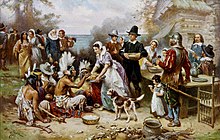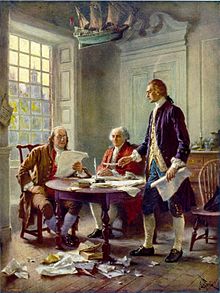art.wikisort.org - Artist
Jean Leon Gerome Ferris (August 8, 1863 – March 18, 1930[1]) was an American painter best known for his series of 78 scenes from American history, entitled The Pageant of a Nation, the largest series of American historical paintings by a single artist.[2]
Jean Leon Gerome Ferris | |
|---|---|
 The First Thanksgiving 1621 | |
| Born | August 8, 1863 |
| Died | March 18, 1930 (aged 66) Philadelphia, Pennsylvania |
| Nationality | American |
| Education | Pennsylvania Academy of the Fine Arts |
| Known for | Painting |


Early life
Ferris was born in Philadelphia, Pennsylvania, the son of Stephen James Ferris, a portrait painter who was a devotee of Jean-Léon Gérôme (after whom he was named) and also an admirer of Mariano Fortuny.[3] He grew up around art; he was trained by his father[2] and his uncles Edward Moran and Thomas Moran were both acclaimed painters.[4]
Ferris enrolled in the Pennsylvania Academy of the Fine Arts in 1879 and trained further at the Académie Julian beginning in 1883 under William-Adolphe Bouguereau.[2] He also met his namesake Jean-Léon Gérôme, who greatly influenced his decision to paint scenes from American history. Ferris wrote, "[Gérôme's] axiom was that one would paint best that with which he is most familiar".[4]
Career
His early subjects were Orientalist in nature since that movement was in vogue when he was young. In 1882, he exhibited a painting entitled Feeding the Ibis which was valued at $600.[5] By 1895, he had gained a reputation as a historical painter, and he embarked on his dream of creating a series of paintings that told a historical narrative.[citation needed]
In 1898, he sold General Howe's Levee, 1777, but he later realized that such a series could not be complete if the separate paintings could not be kept together. Consequently, he never sold another, but he did sell the reproduction rights to various publishing companies. This had the effect of greatly popularizing his work, as these companies made prints, postcards, calendars, and blank-backed trade cards to use in advertisements. Laminated cards of these works were still being sold as late as 1984.[2]
Personal life
Ferris married Annette Amelia Ryder in 1894, and the couple had a daughter named Elizabeth Mary.[6] He died in Philadelphia, Pennsylvania in 1930 at age 66.
Legacy
The paintings showed idealized portrayals of famous moments from American history. The complete series was shown at Independence Hall in Philadelphia from 1913 to 1930, then moved next door to Congress Hall. In later years, it was shown in a number of locations, including the Smithsonian Institution, before being returned to the Ferris family.[5] His works were widely popular for many years, but modern critics are far less generous in their praise.
The American Philosophical Society claims that his historical paintings confuse "verity with verisimilitude",[7] and art historian Gerald Ackerman describes them as "splendid in the accuracy of accessories, clothing and especially in the details of land conveyances and ships", but "extremely dry in execution and rather monotonous in composition."[5]
References
- Sponsel, Rudolf. "J.L.G. Ferris (1863–1930)" (in German). Allgemeine und Integrative Psychotherapie. Retrieved 2010-08-01.
- Nuhn, Roy (April 2007). "J. L. G. Ferris". The Antique Shoppe Newspaper. Retrieved 2010-08-01.
- "The Ferris Collection". Building a National Collection. Smithsonian Institution. Retrieved 2010-08-01.
- Mitnick, Barbara J. (1993). "Paintings for the People". In Ayres, William (ed.). Picturing History: American Painting 1770–1930. Rizzoli International Publications. pp. 167–8. ISBN 0-8478-1745-8.
- Ackerman, Gerald M. (1994). American Orientalists. ACR Edition. pp. 82–3. ISBN 2-86770-078-7.
- The National cyclopaedia of American biography, Volume 13. J. T. White Co. 1906. p. 403.
- Fanelli, Doris Devine; Diethorn, Karie (2001). History of the portrait collection, Independence National Historical Park. American Philosophical Society. p. 55. ISBN 0-87169-242-2.
External links
 Media related to Jean Leon Gerome Ferris at Wikimedia Commons
Media related to Jean Leon Gerome Ferris at Wikimedia Commons
На других языках
- [en] Jean Leon Gerome Ferris
[es] Jean Leon Gerome Ferris
Jean Leon Gerome Ferris (Filadelfia, Pensilvania, 8 de agosto de 1863 - Filadelfia, 18 de marzo de 1930[1]) fue un pintor estadounidense conocido por la serie de 78 escenas de la historia de Estados Unidos, titulada The Pageant of a Nation (El desfile de una nación), la mayor serie de pinturas históricas estadounidenses realizada por un solo artista.[2][fr] Jean Leon Gerome Ferris
Jean-Léon Gérôme Ferris, dit Gerome Ferris ou J. L. G. Ferris, né le 18 août 1863 à Philadelphie où il est mort le 18 mars 1930, est un peintre d’histoire américain surtout connu pour sa série de 78 scènes de l’histoire américaine, intitulée Reconstitution historique d’une nation, la plus grande série de peintures historiques américaines réalisée par un seul artiste[1].[ru] Феррис, Жан Леон Жером
Жан Леон Жером Феррис (англ. Jean Leon Gerome Ferris; родился 18 августа 1863 года, Филадельфия, штат Пенсильвания, США — умер 18 марта 1930 года, там же) — американский художник, более известный как исторический живописец.Другой контент может иметь иную лицензию. Перед использованием материалов сайта WikiSort.org внимательно изучите правила лицензирования конкретных элементов наполнения сайта.
WikiSort.org - проект по пересортировке и дополнению контента Википедии